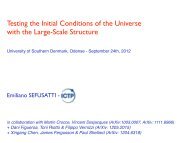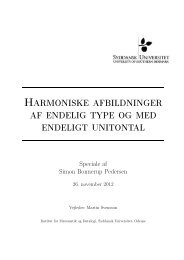A high-resolution version for printing - CP3-Origins
A high-resolution version for printing - CP3-Origins
A high-resolution version for printing - CP3-Origins
Create successful ePaper yourself
Turn your PDF publications into a flip-book with our unique Google optimized e-Paper software.
Unification of the Forces: Why do we have so many different interactions? It is appealing to<br />
imagine that the SM <strong>for</strong>ces could unify into a single Grand Unified Theory (GUT). We could<br />
imagine that at very <strong>high</strong> energy scales gravity also becomes part of a unified description of<br />
nature.<br />
There is no doubt that the SM is incomplete since we cannot even account <strong>for</strong> a number of basic<br />
observations:<br />
Neutrino Physics: Only recently it has been possible to have some definite answers about properties<br />
of neutrinos. We now know that they have a tiny mass, which can be naturally accommodated<br />
in extensions of the SM, featuring <strong>for</strong> example a “see-saw” mechanism. We do not yet<br />
know if the neutrinos have a Dirac or a Majorana nature.<br />
Origin of Bright and Dark Mass: Leptons, quarks and the gauge bosons mediating the weak interactions<br />
possess a rest mass. Within the SM this mass can be accounted <strong>for</strong> by the Higgs mechanism,<br />
which constitutes the electroweak symmetry breaking sector of the SM. However, the associated<br />
Higgs particle has not yet been discovered. Besides, the SM cannot account <strong>for</strong> the observed<br />
large fraction of “dark” mass of the universe. What is interesting is that in the universe<br />
the dark matter is about five times more abundant than the known baryonic matter, i.e. “bright”<br />
matter. We do not know why the ratio of dark to bright matter is of order unity.<br />
Matter-Antimatter Asymmetry: From our everyday experience we know that there is very little<br />
“bright” antimatter in the universe. The SM fails to predict the observed excess of matter.<br />
These arguments imply that the SM must be extended or amended to answer the questions<br />
raised above. Several extensions have appeared in the literature but two stand out in the quest<br />
<strong>for</strong> a more fundamental theory at the Fermi scale: Technicolor and Supersymmetry. We aim at<br />
using and developing analytic and numerical (lattice) approaches to study the nonperturbative<br />
properties of these theories. Using the knowledge of the gauge dynamics acquired we will also<br />
make predictions <strong>for</strong> collider physics and cosmology.<br />
CP³-Black book 3








